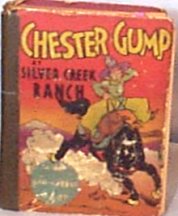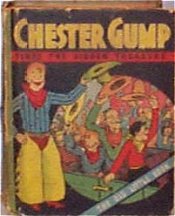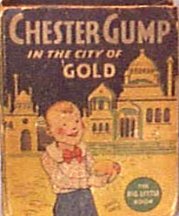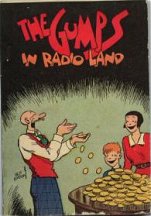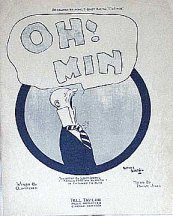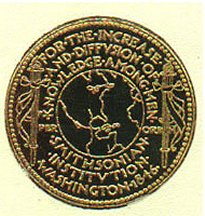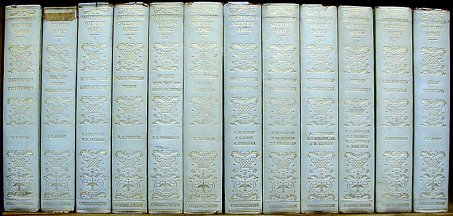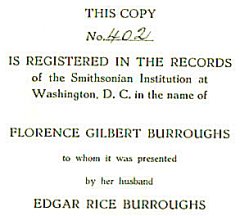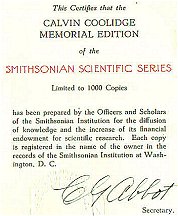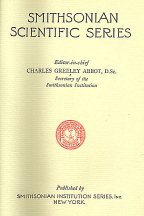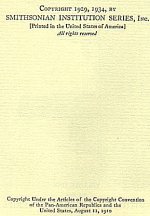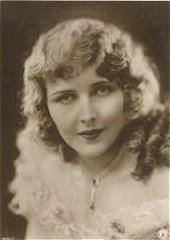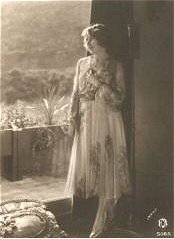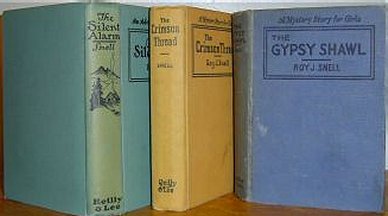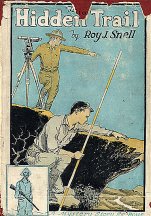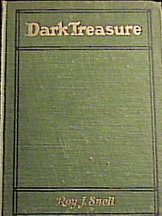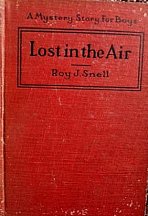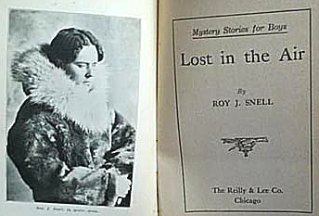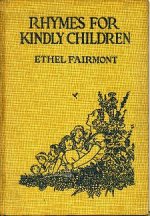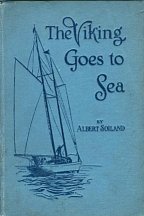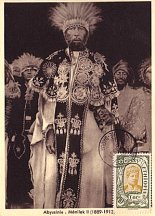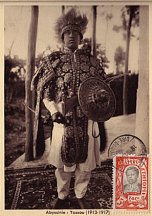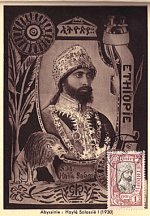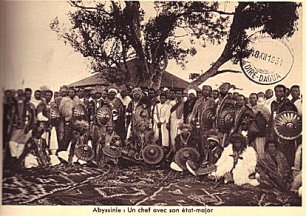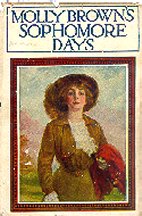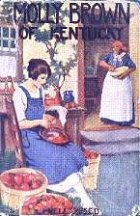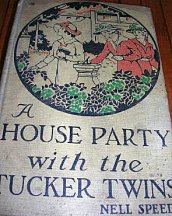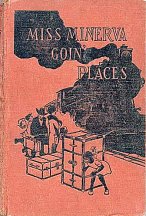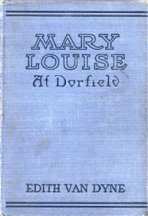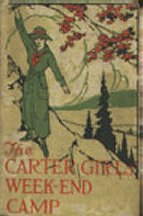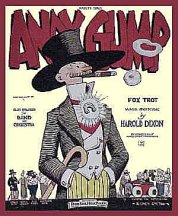 The
Gumps:
Original Medium: Newspaper comics ~ Distributed by: Chicago Tribune
Syndicate ~ First Appeared: 1917 Creator: Sidney Smith The
Gumps:
Original Medium: Newspaper comics ~ Distributed by: Chicago Tribune
Syndicate ~ First Appeared: 1917 Creator: Sidney Smith
When a comics artist wants
to indicate that a character is the heroic type, one of the visual cues
available is to give the character a strong (i.e., large) chin — Dick Tracy
and the lantern-jawed Batman of the late 1930s through the early '60s being
only two examples. Andy Gump, then, was just about the least heroic-looking
character in comics, with the possible exception of A. Mutt. He had absolutely
no chin whatsoever. His neck was stuck right into his upper lip, and his
mouth, when seen, was merely a hole near the top of it. The basic idea
for Andy and his family was supplied by Captain Joseph M. Patterson, the
Chicago Tribune editor/publisher whose many contributions to the world
of comics include Moon Mullins, Winnie Winkle and Little Orphan Annie.
He envisioned a domestic comedy strip about ordinary people — not too bright,
not too rich, not too good-looking — and their ordinary adventures. He
even came up with the name, The Gumps, "gump" being a term he used for
a member of the Uneducated Masses. He hired cartoonist Sidney Smith, whose
major credit to date was a billy goat named Old Doc Yak, to write and draw
the strip, which began on February 12, 1917. It was Smith who fleshed out
the characters and made them come to life. Andy was as heroic as his chin
indicated. In times of stress, he would holler "Oh! Min!" — Min being his
wife and pillar to lean on. They had a son named Chester, a wealthy Uncle
Bim, and a maid named Tilda, who was absolutely insufferable. Smith started
out just doing daily gags about life in and around the Gump household,
but gradually moved toward longer and more complex storylines. Like Gasoline
Alley (another strip Patterson strongly influenced, by the way), it became
an early example of what later came to be known as a soap opera. A Sunday
page was added on June 29, 1919. It was a popular strip right from the
start. When, on June 16, 1919, Patterson launched The New York Daily News,
The Gumps was the only Tribune strip that was in it right from the start.
There, it attracted national attention among newspaper feature editors,
a great many of whom wanted the strip for their own papers. It was to meet
that demand, that Patterson formed The Chicago Tribune-New York News Syndicate
— which, under the name Tribune Media Services, still distributes such
comics as Broom-Hilda, Brenda Starr and Shoe. Soon as the strip achieved
national distribution, the merchandising kicked in. Sheet music in 1919
and 1923, a board game in 1924 and a proliferation of toys were only a
few of the Gumps paraphernalia that could be had. On June 5, 1920, Andy's
Dancing Lesson, the first of dozens of animated cartoons about the characters,
was released. In 1931, The Gumps became the very first comic strip adapted
into a radio show, when Chicago station WGN began broadcasting their adventures.
The strip's popularity increased as Andy ran for Congress in 1922, and
for president in practically every election from 1924 until the strip ended
— one of a long succession of toon candidates for the Oval Office, beginning
with A. Mutt in 1908 and eventually including Alfred E. Neuman, Betty Boop
and Zippy the Pinhead. On April 30, 1929, a major character, Mary Gold,
died — another comic strip first — and reader interest soared. All of a
sudden, anything could happen. In 1922, Smith signed a highly publicized
million-dollar contract — $100,000 per year for ten years, a vast sum in
those days and a pretty good hunk of change even today. And it only went
up from there — in '35, he signed a new contract, giving him $150,000 a
year. It was on the way home from signing the latter that he wrecked his
brand-new Rolls-Royce, killing himself in the process. Patterson hired
sports cartoonist Gus Edson (who later co-created Dondi) to take over the
strip, and Edson's work on it began appearing on December 16, 1935. Tho
Edson made a reasonably successful attempt to continue it in Smith's style,
his version of The Gumps wasn't nearly as popular as Smith's. Except for
a few comic books from Dell and Big Little Books from Whitman (the latter
featuring Andy's and Min's son, Chester), the merchandising dried up. The
strip continued for a couple more decades, but circulation declined steadily.
The plug was pulled on October 17, 1959. By that time, it was appearing
in less than 20 paper
The Gumps was also a strip
of firsts - it was the first comic strip to feature a character's death
(the character was Mary Gold, in 1929), the first to spawn a radio show
(in 1934), and the first to be presented in such a way that each day's
strip told a new chapter of an ongoing story. This soap opera-ish technique
had fans clamoring for more at the end of each strip, and undoubtedly helped
perpetuate its popularity. It was also for The Gumps that the first million-dollar
contract was signed for a comic strip. Sadly, just after signing this contract
in 1935, Sidney Smith was killed in a car accident. His assistant Gus Edson
took over, and though he did a fine job with the strip, there was a certain
magic missing. So while the hi-jinx and hilarity continued for nearly 25
more years, the popularity of the family steadily declined.
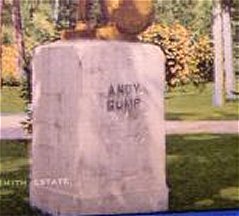
Andy Gump Monument Robert Sidney Smith Estate: Lake
Geneva Wisconsin
Robert
Sidney Smith was the creator of the great American family epic
'The Gumps'. Smith was already almost forty years old when the first panel
of this strip was published, in 1917. In 1908, he published his first comic,
'Buck Nix'. When he got hired by the Chicago Tribune the name changed to
'Old Doc Yak'. In 1919, Smith was forced to abandon this strip due to the
immense popularity of 'The Gumps', which had greatly boosted the Tribune's
circulation. The Gump family brought Smith fame and riches, which he spent
on several houses and cars. The depression of the 1930s did not affect
him, for he was able to sign a new contract with the Tribune that paid
him a million dollars over the next three years, plus a brand new Rolls
Royce as a bonus. Driving home after having closed the deal, Sidney Smith
collided with another car and was killed instantly. After that 'The Gumps'
were taken over by Gus Edson |

